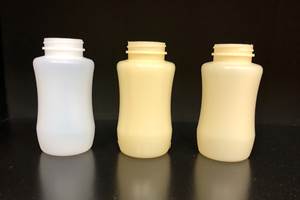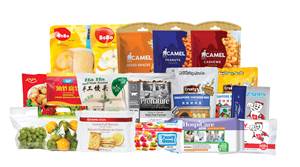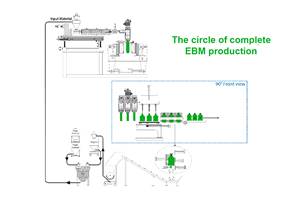All-PP Packaging is More than Likely to Make its Mark in the Monomaterial Trend
Borealis and partners have developed a new PP monomaterial food pouch with high barrier and compatibility for mechanical recycling of PP.
My colleagues and I have been increasingly reporting over the last few years on the monomaterial trend, particularly in the food and non-food packaging arena. Check out these two blogs from earlier this year on ‘Monomaterial’ Trend in Packaging and Beyond Will Only Thrive and In Sustainable Packaging, the Word is ‘Monomaterial’.

All-PE monomaterial structures, particularly in the flexible packaging sector, including standup pouches, have pretty much ruled in terms of commercial success. But, we have been expecting all-PP packaging to make up ground as the overall plastics industry’s aim for a circular economy in pretty much all market sectors has become a key if not dominant consideration. An excellent example is the latest development by Borealis Group and value chain industry partners who have created a monomaterial food pouch containing over 95% PP and designed for recycling.
High barrier packaging is used to preserve and protect foodstuffs that are sensitive to moisture, oxygen, aromas, and light, like dry ingredients and powders, coffee, and snack foods. Producers and consumers benefit from the longer shelf life and reduced food waste made possible by these convenient high barrier pouches. In the extrusion lamination process, laminating PP cast and BOPP (biaxially oriented polypropylene) films yields mono PP laminates with uniquely advantageous properties. These include high barrier and stiffness, and excellent sealing performance.
Using conventional adhesion lamination structures, producers have previously been able to obtain pouch laminate materials containing approximately 90% PP. However, by pooling their respective areas of expertise, Borealis and value chain partners have now been able to boost the share of PP to over 95%. When processed within dedicated mechanical recycling streams for PP, this monomaterial pouch yields greater volumes of high-quality recyclate fit for use in non-food, flexible PP packaging applications.
I asked Borealis sources to confirm the structure of this first prototype and they noted that this type of high-performance flexible packaging is predominantly achieved by the production of a laminate. ‘In our case—two different BOPP films and one cast PP film are glued together to form a high-barrier mono-PP laminate.” They note that this more sustainable high-barrier monomaterial PP packaging format offers a range of benefits for the blown and cast film extrusion processes as well as for brand owners and end consumers.
For one thing, it can help meet ambitious recycling and waste reduction targets set forth in the EU’s Packaging and Packaging Waste Regulation (PPWR) as well as eco-modulation criteria for Extended Producer Responsibility (EPR) programs. They see this packaging as the ideal format with which to fulfil the principle aims of the PPWR: improve recyclability, grow the market for recycled content, and reduce packaging waste.
The high barrier pouch made of over 95% PP is said to demonstrate excellent seal strength and hermetic sealing properties thanks to the material solutions and production expertise contributed by each of the value chain partners involved in this project. Commercially available polyolefins in the Borealis PP extrusion coating and lamination grade portfolio reportedly offer stable processability and good laminate bond strength. These were used in tandem with tie layers contributed by the , a leading international manufacturer of specialty chemicals, including polyolefin-based tie resins.
Meanwhile, as a global leader in the development and manufacture of specialty BOPP films, contributed to this innovative solution for recyclable packaging. With locations in Europe, America, and China. Profol, known for its innovative cast PP films and lightweight composites, produced the cast films. Based in Finland and operating in 38 countries, characterizes it self as “providing solutions that enhance wellbeing and convenience for consumers around the world”, contributed innovative laminates to the new monomaterial pouch.
While eco-modulated EPR fees based on packaging recyclability credentials and recycled content may differ among EU Member States, the new monomaterial pouch made of over 95% PP meets the CEFLEX (Circular Economy for Flexible Packaging) definition of “fully compatible to mechanical recycling PP.” It is thus a cost-saving alternative to conventional pouch formats composed of a greater number of different materials.
Noted Peter Voortmans, Borealis’ global commercial director for consumer products, “In re-inventing essentials for sustainable living, our aim is to uphold the integrity and quality of packaging materials while ensuring that these convenient formats are more and more circular. We are very proud of this value chain collaboration. It equips our partners and customers with yet another viable and more sustainable solution to help manage the updated requirements of the PPWR.”
Related Content
How to Extrusion Blow Mold PHA/PLA Blends
You need to pay attention to the inherent characteristics of biopolymers PHA/PLA materials when setting process parameters to realize better and more consistent outcomes.
Read MoreFlexible-Film Processor Optimizes All-PE Food Packaging
Tobe Packaging’s breakthrough was to create its Ecolefin PE multilayer film that could be applied with a specialized barrier coating.
Read MoreMultilayer Solutions to Challenges in Blow Molding with PCR
For extrusion blow molders, challenges of price and availability of postconsumer recycled resins can be addressed with a variety of multilayer technologies, which also offer solutions to issues with color, processability, mechanical properties and chemical migration in PCR materials.
Read MoreGet Color Changes Right In Extrusion Blow Molding
Follow these best practices to minimize loss of time, material and labor during color changes in molding containers from bottles to jerrycans. The authors explore what this means for each step of the process, from raw-material infeed to handling and reprocessing tails and trim.
Read MoreRead Next
For PLASTICS' CEO Seaholm, NPE to Shine Light on Sustainability Successes
With advocacy, communication and sustainability as three main pillars, Seaholm leads a trade association to NPE that ‘is more active today than we have ever been.’
Read MoreBeyond Prototypes: 8 Ways the Plastics Industry Is Using 3D Printing
Plastics processors are finding applications for 3D printing around the plant and across the supply chain. Here are 8 examples to look for at NPE2024.
Read More













